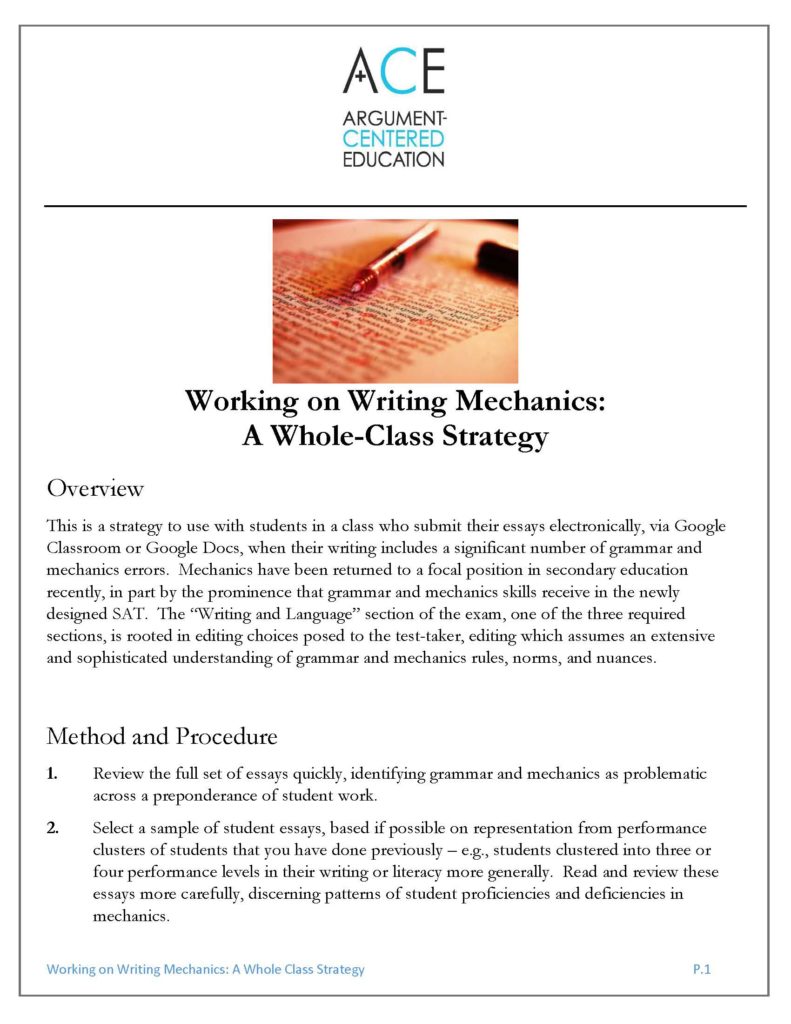
Working on Writing Mechanics: A Whole-Class Strategy
Several of our partner schools’ literacy teachers have coalesced around a concern for the level of command and control over mechanics and grammar that their students demonstrate in the academic writing. They are increasingly aware of the way that their students’ college readiness is being evaluated on the basis of their use of standard, grammatical written English. These schools have been assigning exercises on the fundamentals of mechanics, but these activities are abstracted from the mental maps and actual ways of using grammar embodied by their students’ written work. This activity addresses students own individualized mechanics misunderstandings.
Overview
This is a strategy to use with students in a class who submit their essays electronically, via Google Classroom or Google Docs, when their writing includes a significant number of grammar and mechanics errors. Mechanics have been returned to a focal position in secondary education recently, in part by the prominence that grammar and mechanics skills receive in the newly designed SAT. The “Writing and Language” section of the exam, one of the three required sections, is rooted in editing choices posed to the test-taker, editing which assumes an extensive and sophisticated understanding of grammar and mechanics rules, norms, and nuances.
Method and Procedure
(1)
Review the full set of essays quickly, identifying grammar and mechanics as problematic across a preponderance of student work.
(2)
Select a sample of student essays, based if possible on representation from performance clusters of students that you have done previously – e.g., students clustered into three or four performance levels in their writing or literacy more generally. Read and review these essays more carefully, discerning patterns of student proficiencies and deficiencies in mechanics.
(3)
Create a set of “analytics” on students’ mechanics and grammar. You should include 2 – 3 proficiencies – mechanics that students demonstrate an understanding of that is at or above their grade level – and 3 – 5 deficiencies, common and important mechanics mistakes that students are making. Include one or two examples of each of the analytics from actual student work, keeping the student authors unnamed.
(4)
Present the analytics with supporting work samples to the students. Be sure to emphasize that these are common strengths and errors, but they should be viewed as representative of both larger reserves of understanding and larger gaps of understanding of mechanics and grammar rules, standards, norms, and nuances. Also, make it clear how important control over the mechanics and grammar of writing and speaking has always been, and is even more so today, particularly in light of the elevated place they are getting in the college admissions process.
(5)
Tell students that they will now be doing individual line edits of the essays that they recently submitted. Tell them that you will not be doing these line edits, both because that would take far too much of your time, pushing back the learning that the class has to proceed with next, but also because they will only learn mechanics and grammar through self-correction and through their own initiative. Understanding of mechanics and grammar can never be imposed on a student externally.
(6)
Define line editing for students as the work that editors or self-editors do to correct writing for mechanics and grammar by reading each line on its own as a unit of writing that itself needs to contain no errors in grammar and mechanics. Line editing deliberately sets aside reading for meaning, and focuses entirely on the grammaticality of each individual line.
(7)
Give students a guideline for how many line edits they should make on average: maybe one per line on average, one per every other line, or maybe more than one per line.
(8)
Students should then do their line editing using the Google editing operation called “Suggesting.” They shouldn’t make the direct edits or changes to the text; rather they should “mark up” their essay with grammar and mechanics corrective “suggestions.”
(9)
The teacher should review student work here, by checking it for the quantity of “suggestions” made on their essay draft that they are line editing. Students can get a check-plus (if they have more suggestions than the guideline), a check (if they have a number of suggestions close to the guideline), or a check-minus (if they have fewer suggestions, unless upon a closer look, the student does not have as many mechanics and grammar errors).
(10)
After their line editing is reviewed and checked, students should re-submit their essays. They can be assessed and given a weighted, important grade on their mechanics and grammar that is separate and additional to the assessment they get for the content of their essay – its argument, its use of evidence and reasoning, its critical thinking, its demonstration of content understanding. The rubric for the mechanics and grammar assessment can be quite simple, some variation of the following.
A 0 – 2 grammar or mechanics errors
A – 3 grammar or mechanics errors
B+ 4 grammar or mechanics errors
B 5 – 7 grammar or mechanics errors
B – 8 grammar or mechanics errors
C + 9 grammar or mechanics errors
C 10 – 11 grammar or mechanics errors
C – 12 grammar or mechanics errors
D + 13 grammar or mechanics errors
D 14 – 15 grammar or mechanics errors
F 16 or more grammar or mechanics errors


